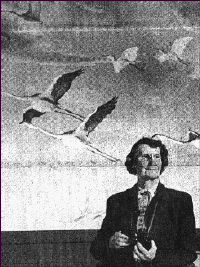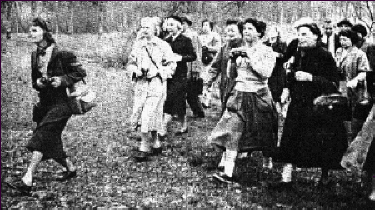Farida Wiley stands in front of the marsh birds exhibit in her
habitat, the American Museum of Natural History.
In her hands is the tool of her trade,
binoculars.

It is late March. The songs of birds are heard in the
early morning. To the initiated and perceptive, the sounds are distinctive: a black and
white warbler, two red-winged blackbirds, a killdeer and a cat bird. For most of us, the
sounds are reminiscent of our youth and recollections of the rites of spring. For 94 year
old Farida Wiley, those sounds meant another season of bird watching and teaching
thousands of New York City dwellers about nature and its fascinating complexity. This is
her story.
Born on her parent's percheron horse
farm in Orange Township in 1889, she quickly developed a fascination with birds. Her
girlhood friends such as the McCrackens wanted to play, but serious minded Farida busied
herself with making regular reports on bird sightings to the U.S. Biological Survey. The
tragic death of both parents when she was young coupled with the marriage and move to New
York of her sister Bessie left her with little alternative but to follow Bessie to the big
city. A bird watcher and nature lover in New York City?
Bessie helped her get a job at the prestigious American Museum of Natural History
teaching blind children. The year was 1919. The rest, as they say, is history. Miss Wiley
[as she was referred to by everyone] continued for the next 64 years to make glad the
heart of not only children but of the taciturn New Yorkers as well. She was foremost an
ornithologist, and Central Park was her haven. For nearly half a century she led daily 7
a.m. bird walks in the park.
Central
Park was a resting place for many species of migratory birds. As a fascinated columnist
for the New York Herald Tribune observed in a 1961 column: "Nobody could match the
eagle eye of Miss Wiley, who in short order spotted a phobe, downey woodpecker, yellow
bellied sapsucker, white-throated sparrow and many others."
When her walks began, she regularly spotted
close to 250 different species. Toward the end, the count would not exceed 50. She blamed
the use of pesticides. Her rules were strict and quickly enforded. "We do not
smoke in a sanctuary - and take nothing from it!" As the social patterns in the
city changed, Miss Wiley did not. When asked by a Washington Post reporter one day what
she did when she encountered strangers in Central Park, she replied: "We just step
right over them."
She tried her best to avoid the public eye. With a characteristic "harrumph",
she brushed off publicity and a request to appear on the television show To Tell The
Truth. During her years at the museum she met such notables as Helen Keller, Thomas
Edison, and Edna Ferber. Miss Wiley also worked with such respected ornithologists as
Roger Tory Peterson and Frank Champman.
She was completely self taught in the fields of natural sciences. A student of all of
the natural world around her, she authored at least six books, including Theodore
Roosevelt's America and The Definitive Book on Ferns in the Northeast U.S. Her
literary forays included writing book reviews for the Natural History and Audubon
magazines.
Miss Wiley discovered early in her life that her passion for the natural sciences was
much more meaningful if she shared nature's gifts with others - especially young people.
For more than half a century, she spent her summers doing just that. As a member of the
distinguished staff at the Audubon Camp in Maine, she taught Audubon Society members -
experts on birds in their own right - the birding techniques she had developed. Over the
years, Miss Wiley became well known as an instructor in ornithology and the natural
sciences at Columbia University, Penn State and New York University. She freely gave of
her time to numerous public schools in New York City as well.
She found a kindred soul in John Burroughs, one of America's foremost naturalists. The
major theme of his writings was the effect of natural surroundings on the development of
children. Miss Wiley first ventured into literature by compiling and editing his works.
As she passed her 80th birthday and began her fifth decade of bird walks in Central
Park, a New York Times reporter dispatched a memo to her obit file with the
observation that she would probably outlive the editors. New Yorkers enjoyed 19 more years
of Miss Wiley and her bird walks.

Farida Wiley
leads a birdwatching expedition in New York City’s Central Park. Over the years,
the
number of species seen in the park diminished considerably.
Farida Wiley passed away peacefully at age
99. The young girl from Orange Township had made quite an impression on the crusty New
Yorkers. All of the New York newspapers carried lengthy obituaries. Perhaps most
impressive was the three page eulogy of her life which appeared in the Washington Post. "Miss Wiley taught people to make a connection with the world, to look up, and
out, beyond themselves." The Post traced her career and concluded that she
made her greatest contributions as a teacher. "She lead an extraordinary life, and
was a woman of uncommon character, a product of the 19th century who seemed to have drawn
her identity nor from movies or magazines but from a clear sense of purpose, her calling
as a teacher."
What drew her into the hearts of so many of these city dwellers? As the Post noted with respect: "She was self taught - she was old-fashioned - she never drove
a car - and she was revered largely for the principles and predilections that made her
formidable."
This spring when you hear the birds around you, remember Farida Wiley and her legacy.
In this fast-paced life of ours, we would do well to remember her favorite motto as well: "The
most precious things of life are near at hand, without money, and without price."
[ Back to Women Index ] |

